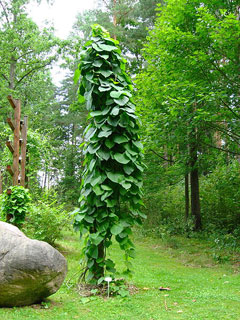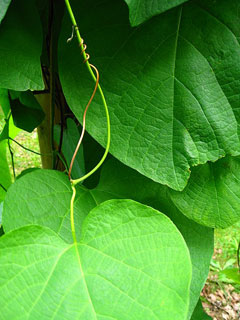 |
|
http://commons.wikimedia.org/wiki/User:Athantor |
 |
| http://commons.wikimedia.org/wiki/User:Athantor |
Translate this page:
Summary
Bloom Color: Green, Purple, Yellow.Main Bloom Time: Early summer, Mid summer. Form: Spreading or horizontal.
Physical Characteristics

 Aristolochia macrophylla is a CLIMBER growing to 7 m (23ft) at a fast rate.
Aristolochia macrophylla is a CLIMBER growing to 7 m (23ft) at a fast rate.
See above for USDA hardiness. It is hardy to UK zone 6. It is in flower from June to August, and the seeds ripen from September to October. The species is hermaphrodite (has both male and female organs) and is pollinated by Flies.
Suitable for: light (sandy), medium (loamy) and heavy (clay) soils and prefers well-drained soil. Suitable pH: mildly acid, neutral and basic (mildly alkaline) soils and can grow in very alkaline soils.
It can grow in semi-shade (light woodland) or no shade. It prefers dry or moist soil.
UK Hardiness Map
US Hardiness Map
Synonyms
Plant Habitats
Woodland Garden Dappled Shade;
Edible Uses
References More on Edible Uses
Medicinal Uses
Plants For A Future can not take any responsibility for any adverse effects from the use of plants. Always seek advice from a professional before using a plant medicinally.
Antiseptic Antitumor
The plant contains the antiseptic and antitumor compound aristolochic acid[222]. A decoction of the root has been used externally to treat 'swelling of feet and legs'[257]. A compound infusion of stalk chips has been used in the treatment of 'yellowish urine'[257].
References More on Medicinal Uses
The Bookshop: Edible Plant Books
Our Latest books on Perennial Plants For Food Forests and Permaculture Gardens in paperback or digital formats.

Edible Tropical Plants
Food Forest Plants for Hotter Conditions: 250+ Plants For Tropical Food Forests & Permaculture Gardens.
More

Edible Temperate Plants
Plants for Your Food Forest: 500 Plants for Temperate Food Forests & Permaculture Gardens.
More

More Books
PFAF have eight books available in paperback and digital formats. Browse the shop for more information.
Shop Now
Other Uses
References More on Other Uses
Cultivation details
Landscape Uses:Arbor, Screen. Prefers a well-drained loamy soil, rich in organic matter, in sun or semi-shade[1, 200], but succeeds in ordinary garden soil[134]. Plants are hardy to at least -10°c[200]. A fast-growing climbing plant, attaching itself by means of twining around other plants, it has been recommended for covering pergolas[200]. Most species in this genus have malodorous flowers that are pollinated by flies[200]. Special Features:Attracts birds, Attractive foliage, North American native, All or parts of this plant are poisonous, Attracts butterflies, Attractive flowers or blooms.
References Carbon Farming Information and Carbon Sequestration Information
Temperature Converter
Type a value in the Celsius field to convert the value to Fahrenheit:
Fahrenheit:
The PFAF Bookshop
Plants For A Future have a number of books available in paperback and digital form. Book titles include Edible Plants, Edible Perennials, Edible Trees,Edible Shrubs, Woodland Gardening, and Temperate Food Forest Plants. Our new book is Food Forest Plants For Hotter Conditions (Tropical and Sub-Tropical).
Shop Now
Plant Propagation
Seed - best sown in a greenhouse as soon as it is ripe in the autumn. Pre-soak stored seed for 48 hours in hand-hot water and surface sow in a greenhouse[134]. Germination usually takes place within 1 - 3 months at 20°c[134]. Stored seed germinates better if it is given 3 months cold stratification at 5°c[200]. When large enough to handle, prick the seedlings out into individual pots and grow them on in the greenhouse for their first winter. Plant out in late spring or early summer after the last expected frosts. Division in autumn[200]. Root cuttings in winter[200].
Other Names
If available other names are mentioned here
Native Range
NORTHERN AMERICA: United States (Pennsylvania, West Virginia, Georgia (north), Kentucky (east), Maryland (west), North Carolina (west), South Carolina, Tennessee, Virginia (west))
Weed Potential
Right plant wrong place. We are currently updating this section.
Please note that a plant may be invasive in one area but may not in your area so it's worth checking.
Conservation Status
IUCN Red List of Threatened Plants Status :

Growth: S = slow M = medium F = fast. Soil: L = light (sandy) M = medium H = heavy (clay). pH: A = acid N = neutral B = basic (alkaline). Shade: F = full shade S = semi-shade N = no shade. Moisture: D = dry M = Moist We = wet Wa = water.
Now available:
Food Forest Plants for Mediterranean Conditions
350+ Perennial Plants For Mediterranean and Drier Food Forests and Permaculture Gardens.
[Paperback and eBook]
This is the third in Plants For A Future's series of plant guides for food forests tailored to
specific climate zones. Following volumes on temperate and tropical ecosystems, this book focuses
on species suited to Mediterranean conditions—regions with hot, dry summers and cool, wet winters,
often facing the added challenge of climate change.
Read More
Expert comment
Author
Lam.
Botanical References
200235270
Links / References
For a list of references used on this page please go here
Readers comment
| Add a comment |
|
If you have important information about this plant that may help other users please add a comment or link below. Only comments or links that are felt to be directly relevant to a plant will be included. If you think a comment/link or information contained on this page is inaccurate or misleading we would welcome your feedback at [email protected]. If you have questions about a plant please use the Forum on this website as we do not have the resources to answer questions ourselves.
* Please note: the comments by website users are not necessarily those held by PFAF and may give misleading or inaccurate information.
To leave a comment please Register or login here All comments need to be approved so will not appear immediately.
|
Subject : Aristolochia macrophylla
|
|
|
|